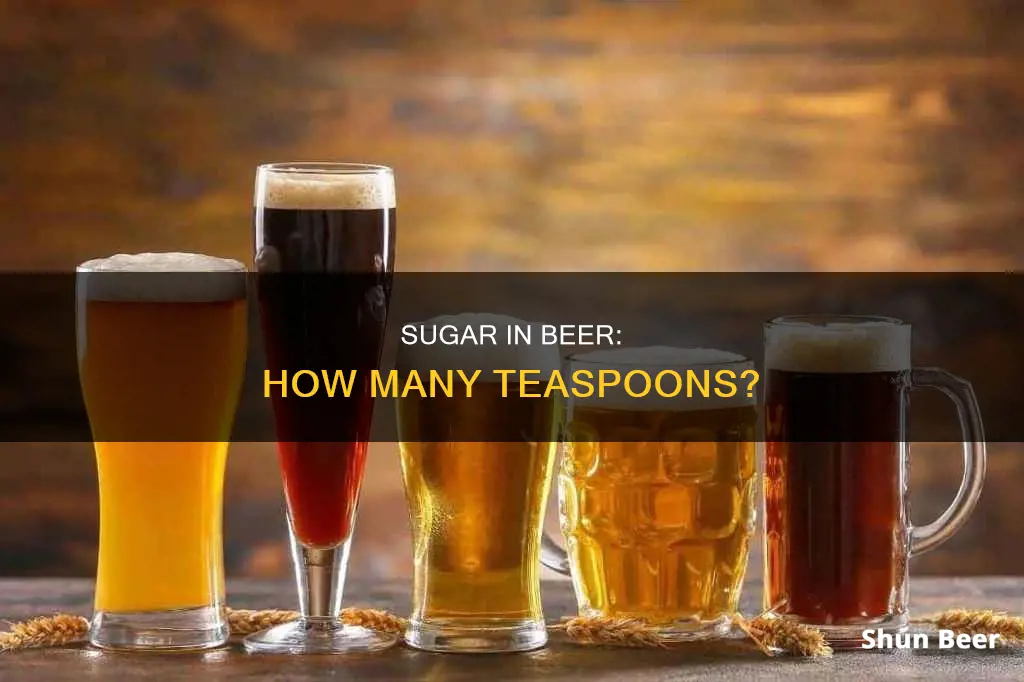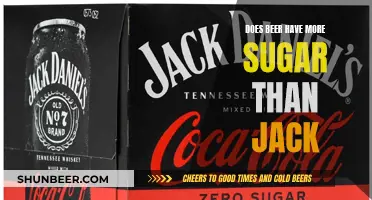
Beer is generally made from yeast, grains, spices, and water. While sugar is not directly added to the mix, it is created naturally when the grains are processed and fermented by yeast. The sugar content of beer depends on several factors, including its gravity, the type of yeast used, and any additional flavours included, such as honey or corn syrup. The sugar content of beer is generally low, but it can still affect your blood sugar levels. Regular beers tend to be sugar-free, while light beers may have up to 1 gram of sugar per can. Non-alcoholic beers have the highest sugar content among the different types of beer.
What You'll Learn
- Beer is made from grains, spices, yeast, and water
- Sugar is created when grains are processed and fermented by yeast
- Beer's final sugar content depends on its gravity, yeast type, and added flavours
- Non-alcoholic beer has the highest sugar content
- Beer can lower blood sugar levels, so it's best consumed with food

Beer is made from grains, spices, yeast, and water
The first step in brewing beer is malting. This involves controlled germination of the grain, which helps break down stored starch into fermentable sugar, mainly maltose. The grain used is usually barley, although wheat, maize, rice, and oats are also used. The malted grain is then mixed with very hot water to create a mash. This process is called mashing, and it activates the natural enzymes in the yeast, turning starch into sugar. The sugary liquid that results is called wort.
The next step is lautering, where the wort is separated from the grain by pouring heated water over it to rinse off any remaining sugars. Boiling comes next, which gets rid of remaining enzymes and oxygen and stabilises the wort in preparation for the addition of hops. Hops add bitterness to balance out the sugar from the wort and act as a natural preservative.
With the brewing complete, fermentation happens by quickly cooling the brew and adding yeast. Fermentation is a two-part process. Primary fermentation sees the yeast convert sugars into alcohol and carbon dioxide, and secondary fermentation allows the beer's flavours to fully develop and add complexity.
Finally, the beer is bottled, canned, or kegged and left to condition for at least two weeks before it is ready to drink.
While beer is made from grains, spices, yeast, and water, it does not contain much sugar. The sugar in beer is created by something called beer gravity, which refers to the density of the wort relative to water at various stages of fermentation. A wort with a high sugar concentration is called a high gravity wort. Once yeast is introduced, the sugar content decreases while the alcohol content goes up. Therefore, beers with higher alcohol content tend to have a lower sugar content.
Beer and Blood Sugar: What's the Connection?
You may want to see also

Sugar is created when grains are processed and fermented by yeast
Sugar is a key ingredient in beer brewing, and it is produced naturally when grains are processed and fermented by yeast. This process is known as beer gravity, and it refers to the density of the liquid extracted from the mashing process during brewing, called the wort. The wort is created by roasting, milling, and soaking the germinated grains in hot water, resulting in a sugar-containing liquid.
The fermentation process involves adding yeast to the wort to convert sugars into alcohol and carbon dioxide. Yeast is a living organism that feeds on sugar, and it has been around for millions, if not billions, of years. During fermentation, yeast consumes sugar and converts it into alcohol and carbon dioxide, or water and carbon dioxide if oxygen is present. This process creates an oxygen barrier, ensuring the yeast cells can work undisturbed, and it is how beer or wine gets its alcohol content.
The amount of sugar present affects the rate of yeast fermentation. Fructose and glucose are highly fermentable sugars, while maltose, which is found in grains, is harder for yeast to break down. This is why wines, which are rich in fructose and glucose, have a higher alcohol percentage than beers. Additionally, the type of yeast and any additional flavours, such as honey or corn syrup, can impact the final sugar content of the beer.
While sugar is not added directly to the list of beer ingredients, it is created through the processing of grains and is essential for producing alcohol. The sugar content in beer is typically low, and labeling regulations do not require manufacturers to disclose it. However, it is important to note that alcoholic beverages can still affect blood sugar levels, and consumption should be in moderation.
Sugar Quantity for Brewing 40 Pints of Beer
You may want to see also

Beer's final sugar content depends on its gravity, yeast type, and added flavours
The final sugar content of beer depends on several factors, including its gravity, the type of yeast used, and any added flavours. Let's explore each of these factors in more detail:
Gravity
Beer gravity refers to the density of the wort—the liquid extracted from malted barley—relative to water, at various stages of fermentation. This density is largely determined by the sugar content of the wort. During fermentation, yeast converts sugars into alcohol and carbon dioxide, resulting in a decrease in sugar content and an increase in alcohol content. Therefore, a beer's gravity decreases as fermentation progresses. The difference between the initial and final gravity readings indicates how much sugar has been converted into alcohol. High-gravity beers tend to have more sugar and produce higher sugar levels post-fermentation, resulting in a stronger beer. On the other hand, low-gravity beers typically contain less sugar and have a lower alcohol content.
Yeast Type
The type of yeast used in fermentation also affects the final sugar content of beer. Yeast strains differ in their ability to convert sugar into alcohol, with some being more efficient than others. For example, ale yeasts have a higher alcohol tolerance than lager yeasts, allowing them to survive in higher alcohol environments. As a result, ales generally have a lower sugar content than lagers. Additionally, yeast strains may exhibit different preferences for the types of sugar they metabolize first. Most yeast strains prefer glucose, but some may consume maltose at the same time as other monosaccharides. Understanding these preferences is crucial for brewers when formulating their recipes.
Added Flavours
Brewers may add various sugars or sugar-containing ingredients to their beers to enhance flavour or increase alcohol content. These additions can include honey, maple syrup, corn syrup, or fruit juices, each contributing unique flavours and aromas to the final product. However, it's important to note that while these additions may increase the sugar content of the wort, the yeast will eventually ferment these sugars, impacting the final sugar content of the beer. The type and amount of sugar added will depend on the desired style and flavour profile of the beer.
In summary, the final sugar content of beer is influenced by its gravity, the choice of yeast, and any additional flavour components. Brewers carefully manipulate these factors to create beers with varying sugar levels, alcohol contents, and flavour profiles to cater to diverse consumer preferences.
Stoney's Beer Sugar Content: What You Need to Know
You may want to see also

Non-alcoholic beer has the highest sugar content
Regular beers are typically sugar-free, and light beers contain barely any sugar, with less than one gram per can. However, non-alcoholic beers have the highest sugar content of all.
Non-alcoholic beer has a much higher sugar content than its alcoholic counterparts. For example, Coors Non-Alcoholic Beer contains 8 grams of sugar, while the alcoholic version, Coors Light, contains only 1 gram. Similarly, Bavaria alcohol-free wheat beer contains 3.6 grams of sugar, whereas its full-strength counterpart, Hoegarden's wheat beer, contains just 0.1 grams.
The reason for this discrepancy lies in the brewing process. In regular beer, sugar is converted into alcohol by yeast during fermentation. In non-alcoholic beer, the goal is to avoid creating alcohol, so the sugar remains in the final product.
It is worth noting that the sugar content of non-alcoholic beer is still relatively low, ranging from 1.5 grams to 28.5 grams per serving. Additionally, some non-alcoholic beers are lower in sugar than others, so it is always a good idea to check the nutritional information before consuming.
While non-alcoholic beer may have a higher sugar content, it is important to consider the overall calorie count as well. Alcoholic beer tends to have more calories due to the presence of pure alcohol, which has around 7 calories per gram. So, while non-alcoholic beer may have more sugar, it often has fewer calories overall.
Starch and Sugar in Beer: What's the Truth?
You may want to see also

Beer can lower blood sugar levels, so it's best consumed with food
The amount of sugar in beer varies depending on the type and brand. For example, a light beer typically has slightly more sugar than a regular beer, while non-alcoholic beer has the highest sugar content. However, the sugar content in beer is generally very low. On average, a 12-ounce (355 ml) serving of regular beer contains 12.8 grams of carbohydrates and no sugar, while a light beer contains 5.9 grams of carbohydrates and 0.3 grams of sugar.
Beer is produced by fermenting sugar, which is created by processing grains with yeast. This process results in a low final sugar content, as the sugar is converted into alcohol. Despite the low sugar content, beer contains carbohydrates, which can affect blood sugar levels. Additionally, alcohol impairs the body's ability to regulate blood sugar by inhibiting gluconeogenesis and glycogenolysis, which are necessary for maintaining blood sugar balance.
As a result, consuming beer can lead to a drop in blood sugar levels, known as hypoglycemia. This effect is particularly pronounced when beer is consumed on an empty stomach or without a carbohydrate-containing meal. Therefore, it is generally recommended to drink beer in moderation and accompany it with food, especially for individuals with diabetes. Drinking beer with a meal or a carbohydrate-rich snack helps maintain normal blood sugar levels and reduces the risk of hypoglycemia.
It is worth noting that the symptoms of excessive alcohol consumption can be similar to those of low blood sugar, such as flushing, nausea, increased heart rate, and slurred speech. This similarity can make it challenging to distinguish between the two conditions. Additionally, alcohol may interfere with the effectiveness of hypoglycemic medications. Therefore, it is crucial to monitor blood sugar levels before, during, and after drinking, especially for individuals with diabetes or those taking hypoglycemic medications.
Lite Beer and Sugar: What's the Truth?
You may want to see also
Frequently asked questions
On average, there is around 1 gram of sugar in a single beer. However, this varies depending on the type of beer. For example, light beers have around 0.3 grams of sugar, while non-alcoholic beers have around 28.5 grams.
Beer has a relatively low sugar content, but it can still affect your blood sugar levels. Alcohol impairs sugar metabolism by blocking the liver's release of blood sugar-regulating hormones, which can lead to hypoglycemia or low blood sugar levels. Therefore, it is generally recommended to consume beer with a carb-containing meal.
The final sugar content of beer depends on several factors, including its gravity, the type of yeast used, and any additional flavours included, such as honey or corn syrup. Beer gravity refers to the density of the wort, which is influenced by the sugar content during the fermentation process.







